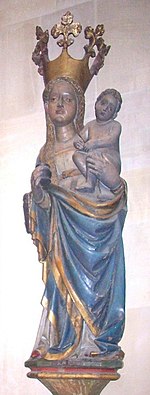Inkwell Madonna
As inkwell Madonna a 1430 created by a Lower Saxony carver is late Gothic sculpture of the Virgin Mary in Hildesheim Cathedral referred.
The colored aggregate , life-sized wooden statue was built around 1430 probably in Lower Saxony and the characteristics of the shows points or beautiful style : tenderness of the faces dissolved attitude, flowing folds of the garment.
Over her white petticoat, Maria wears a precious blue, gold-lined robe that falls from her right shoulder. On her head she wears a high golden crown with five three-leaved lilies . The unclothed baby Jesus sits on her left arm . He bends down, away from the mother, in the same line of sight as her, down to the viewer.
The peculiarity of the representation consists in the motif of writing : The child is holding a pen in his right hand ; on his knees lies a scroll that has been unrolled to his feet. His mother holds the inkwell ready for him in his right hand that gave the representation its name.
The obvious interpretation is that the baby Jesus (admittedly still very young) learns to write from the mother. In addition, the book of life is surely to be remembered in which the names of the redeemed are inscribed. It is the Son of God and Mary who records the believers in the book of salvation. Maria contributes by providing the "substance".
The Inkwell Madonna, which was originally located in the chapter house of the Hildesheim cathedral chapter , is today the most important image of the Virgin Mary in the Cathedral of Mary. From 1960 to 2010 it had its place on the southwestern, since 2014 on the northwestern crossing pillar.
literature
- Herbert von Eine : To the 'Ink Pot Madonna' of Hildesheim Cathedral . In: Alt-Hildesheim 10, 1930, pp. 16-19.
Web links
- Description on the pages of the Hildesheim Cathedral
- Information on the computed tomographic examination of the statue on the website of the HAWK Hildesheim
- Film on the restoration of the Inkwell Madonna on the pages of Hildesheim Cathedral
